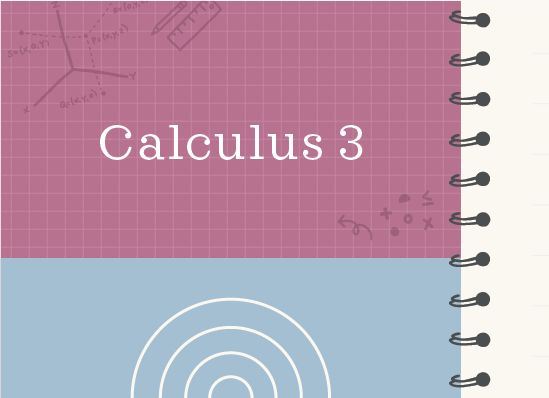Finding volume from triple integrals
Setting up a triple integral to find volume
We can use triple integrals to solve for the volume of a solid three-dimensional object. The volume formula is
???V=\int\int\int_Ef(x,y,z)\ dV???
where ???E??? represents the solid object. We’ll wind up replacing ???dV??? with ???dx???, ???dy??? and ???dz???.
Hi! I'm krista.
I create online courses to help you rock your math class. Read more.
We can integrate in any order, so we’ll try to integrate in whichever order is easiest, depending on the limits of integration, which we’ll find by analyzing the object ???E???.
Keep in mind that, when it comes to limits of integration, you want limits that are in terms of the variables left to be integrated. As an example, if we choose to integrate first with respect to ???z???, then ???y???, then ???x???, then our volume integral will look like
???V=\int\int\int_Ef(x,y,z)\ dz\ dy\ dx???
Since we’d be integrating ???z??? first, that means we won’t have integrated with respect to ???y??? or ???x??? yet, which means we want our limits of integration for ???z??? to be in terms of ???x??? and ???y???, or constants.
Similarly, since we won’t have integrated yet with respect to ???x??? when we do the integration for ???y???, we want our limits of integration for ???y??? to be in terms of ???x???, or constants.
Since ???x??? is the last variable to be integrated, we want our limits of integration for ???x??? to be constants.
Using triple integrals to find the volume of a solid
Take the course
Want to learn more about Calculus 3? I have a step-by-step course for that. :)
Finding volume of the tetrahedron enclosed by the coordinate planes
Example
Use a triple integral to find the volume of the tetrahedron enclosed by ???3x+2y+z=6??? and the coordinate planes.
The most traditional order of integration is ???z???, then ???y???, then ???x???, so that’s what we’ll do here. That means we’ll need limits of integration as follows:
Since the tetrahedron rests on the coordinate planes, we know that the lower limit of integration for ???x???, ???y??? and ???z??? will be ???0???.
To find the upper limit of integration for ???x??? (a constant), we’ll set ???y=0??? and ???z=0??? in ???3x+2y+z=6??? and then solve for ???x???.
???3x+2y+z=6???
???3x+2(0)+0=6???
???3x=6???
???x=2???
This means that the limits of integration for ???x??? are ???[0,2]???.
To find the upper limit of integration for ???y??? (a value in terms of ???x???), we’ll set ???z=0??? and then rearrange ???3x+2y+z=6??? so that it’s solved for ???y??? in terms of ???x???.
???3x+2y+z=6???
???3x+2y+0=6???
???3x+2y=6???
???2y=6-3x???
???y=3-\frac32x???
This means that the limits of integration for ???y??? are ???[0,3-(3/2)x]???.
To find the upper limit of integration for ???z??? (a value in terms of ???x??? and ???y???), we’ll solve ???3x+2y+z=6??? for ???z???.
???3x+2y+z=6???
???z=6-3x-2y???
This means that the limits of integration for ???z??? are ???[0,6-3x-2y]???.
Plugging everything into the triple integral, we get
???V=\int^2_0\int^{3-\frac{3}{2}x}_0\int^{6-3x-2y}_01\ dz\ dy\ dx???
Since we're finding the volume of the shape itself and our limits of integration are in terms of the shape, the function we are integrating will simply be ???f(x,y,z)=1???.
Keep in mind that, when it comes to limits of integration, you want limits that are in terms of the variables left to be integrated.
We always integrate from the inside out, so we’ll integrate first with respect to ???z???, treating all other variables as constants.
???V=\int^2_0\int^{3-\frac{3}{2}x}_0z\Big|^{z=6-3x-2y}_{z=0}\ dy\ dx???
???V=\int^2_0\int^{3-\frac{3}{2}x}_06-3x-2y-0\ dy\ dx???
???V=\int^2_0\int^{3-\frac{3}{2}x}_06-3x-2y\ dy\ dx???
Now we’ll integrate with respect to ???y???, treating all other variables as constants.
???V=\int^2_06y-3xy-y^2\Big|^{y=3-\frac{3}{2}x}_{y=0}\ dx???
???V=\int^2_06\left(3-\frac32x\right)-3x\left(3-\frac32x\right)-\left(3-\frac32x\right)^2-\left[6(0)-3x(0)-(0)^2\right]\ dx???
???V=\int^2_018-9x-9x+\frac{9x^2}{2}-\left(9-9x+\frac{9x^2}{4}\right)\ dx???
???V=\int^2_018-9x-9x+\frac{9x^2}{2}-9+9x-\frac{9x^2}{4}\ dx???
???V=\int^2_09-9x+\frac{18x^2}{4}-\frac{9x^2}{4}\ dx???
???V=\int^2_09-9x+\frac{9x^2}{4}\ dx???
Now we’ll integrate with respect to ???x???.
???V=9x-\frac92x^2+\frac{9x^3}{4(3)}\Big|^2_0???
???V=9x-\frac{9x^2}{2}+\frac{3x^3}{4}\Big|^2_0???
???V=9(2)-\frac{9(2)^2}{2}+\frac{3(2)^3}{4}-\left[9(0)-\frac{9(0)^2}{2}+\frac{3(0)^3}{4}\right]???
???V=18-\frac{36}{2}+\frac{24}{4}???
???V=18-18+6???
???V=6???
The volume of the solid is ???6??? cubic units.







